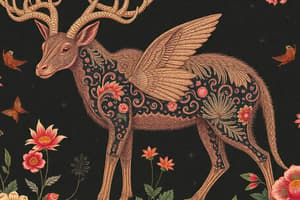Podcast
Questions and Answers
What is a characteristic of Animalia that distinguishes them from plants and fungi?
What is a characteristic of Animalia that distinguishes them from plants and fungi?
- Autotrophic nutrition
- Multicellular organization
- Ability to move and respond to stimuli (correct)
- Presence of cell walls
Which of the following types of nutrition is NOT characteristic of Animalia?
Which of the following types of nutrition is NOT characteristic of Animalia?
- Detritivory
- Herbivory
- Autotrophy (correct)
- Carnivory
What is the primary method of reproduction in most animals?
What is the primary method of reproduction in most animals?
- Budding
- Sexual reproduction (correct)
- Asexual reproduction
- Fragmentation
Which phylum includes insects, arachnids, and crustaceans?
Which phylum includes insects, arachnids, and crustaceans?
What is the approximate number of described species in the kingdom Animalia?
What is the approximate number of described species in the kingdom Animalia?
What is the range of sizes of animals in the kingdom Animalia?
What is the range of sizes of animals in the kingdom Animalia?
What is the primary function of the ovary in an angiosperm?
What is the primary function of the ovary in an angiosperm?
Which part of the flower is responsible for producing seeds?
Which part of the flower is responsible for producing seeds?
What is the result of fertilization in angiosperms?
What is the result of fertilization in angiosperms?
What is the significance of angiosperms in terms of their diversity and dominance on Earth?
What is the significance of angiosperms in terms of their diversity and dominance on Earth?
What is the order of events in the life cycle of an angiosperm?
What is the order of events in the life cycle of an angiosperm?
What is the vascular tissue found in the stems, roots, and leaves of angiosperms?
What is the vascular tissue found in the stems, roots, and leaves of angiosperms?
Flashcards are hidden until you start studying
Study Notes
Characteristics of Animalia
- Multicellular, eukaryotic organisms
- Heterotrophic (obtain energy by consuming other organisms)
- Lack cell walls (unlike plants and fungi)
- Ability to move and respond to stimuli
Body Structure
- Most animals have a definite body shape and structure
- Body cavities (coelom) present in most animals
- Three main body layers: ectoderm, endoderm, and mesoderm
Nutrition
- Obtain energy by consuming other organisms (heterotrophic)
- Types of nutrition:
- Herbivory (plant-eating)
- Carnivory (meat-eating)
- Omnivory (eating both plants and animals)
- Detritivory (eating dead organic matter)
Reproduction
- Sexual reproduction (most animals)
- Asexual reproduction (some animals, e.g. starfish, corals)
- Development:
- Embryonic development (most animals)
- Larval development (some animals, e.g. insects, frogs)
Classification
- Kingdom: Animalia
- Phyla (body structure-based classification):
- Chordata (vertebrates and some invertebrates)
- Arthropoda (insects, arachnids, crustaceans)
- Mollusca (squids, octopuses, clams, snails)
- Echinodermata (starfish, sea urchins, sea cucumbers)
- Many others
Diversity
- Over 30 phyla and 100,000 described species
- Found in almost every habitat on Earth, from deserts to deep-sea vents
- Range in size from tiny (e.g. fairyfly, 0.2 mm) to massive (e.g. blue whale, up to 30 meters)
Characteristics of Animalia
- Multicellular, eukaryotic organisms
- Obtain energy by consuming other organisms (heterotrophic)
- Lack cell walls, unlike plants and fungi
- Ability to move and respond to stimuli
Body Structure
- Most animals have a definite body shape and structure
- Body cavities (coelom) present in most animals
- Three main body layers: ectoderm, endoderm, and mesoderm
Nutrition
- Obtain energy by consuming other organisms (heterotrophic)
- Types of nutrition:
- Herbivory (plant-eating)
- Carnivory (meat-eating)
- Omnivory (eating both plants and animals)
- Detritivory (eating dead organic matter)
Reproduction
- Sexual reproduction (most animals)
- Asexual reproduction (some animals, e.g. starfish, corals)
- Development:
- Embryonic development (most animals)
- Larval development (some animals, e.g. insects, frogs)
Classification
- Kingdom: Animalia
- Phyla (body structure-based classification):
- Chordata (vertebrates and some invertebrates)
- Arthropoda (insects, arachnids, crustaceans)
- Mollusca (squids, octopuses, clams, snails)
- Echinodermata (starfish, sea urchins, sea cucumbers)
- Many others
Diversity
- Over 30 phyla and 100,000 described species
- Found in almost every habitat on Earth, from deserts to deep-sea vents
- Range in size from tiny (e.g. fairyfly, 0.2 mm) to massive (e.g. blue whale, up to 30 meters)
Angiosperm Definition
- Angiosperms are a group of flowering plants that produce seeds enclosed in an ovary, also known as Angiospermae or Magnoliophyta.
Characteristics
- Produce flowers, fruits, and seeds.
- Seeds develop from ovules in the ovary of a flower.
- Ovary is the female reproductive organ of the flower.
- Fruits develop from the ovary and surround the seeds.
- Vascular tissues (xylem and phloem) are present in stems, roots, and leaves.
Reproductive Structures
- Flowers are the reproductive structures of angiosperms.
- Composed of:
- Sepals: protective structures that cover the flower bud.
- Petals: colorful structures that attract pollinators.
- Stamens: male reproductive organs that produce pollen.
- Carpels: female reproductive organs that contain ovules.
Life Cycle
- Begins with seed germination.
- Seedling develops into a mature plant.
- Plant produces flowers, which are pollinated.
- Fertilization occurs, resulting in seed formation.
- Seeds mature and disperse, starting a new cycle.
Evolutionary Significance
- Angiosperms are the most diverse and dominant plant group on Earth.
- Evolved from gymnosperms (seed-producing plants) around 130 million years ago.
- Rapid diversification and adaptation to different environments contributed to their success.
Examples
- Common examples of angiosperms include:
- Roses
- Sunflowers
- Tomatoes
- Grasses
- Orchids
Studying That Suits You
Use AI to generate personalized quizzes and flashcards to suit your learning preferences.




